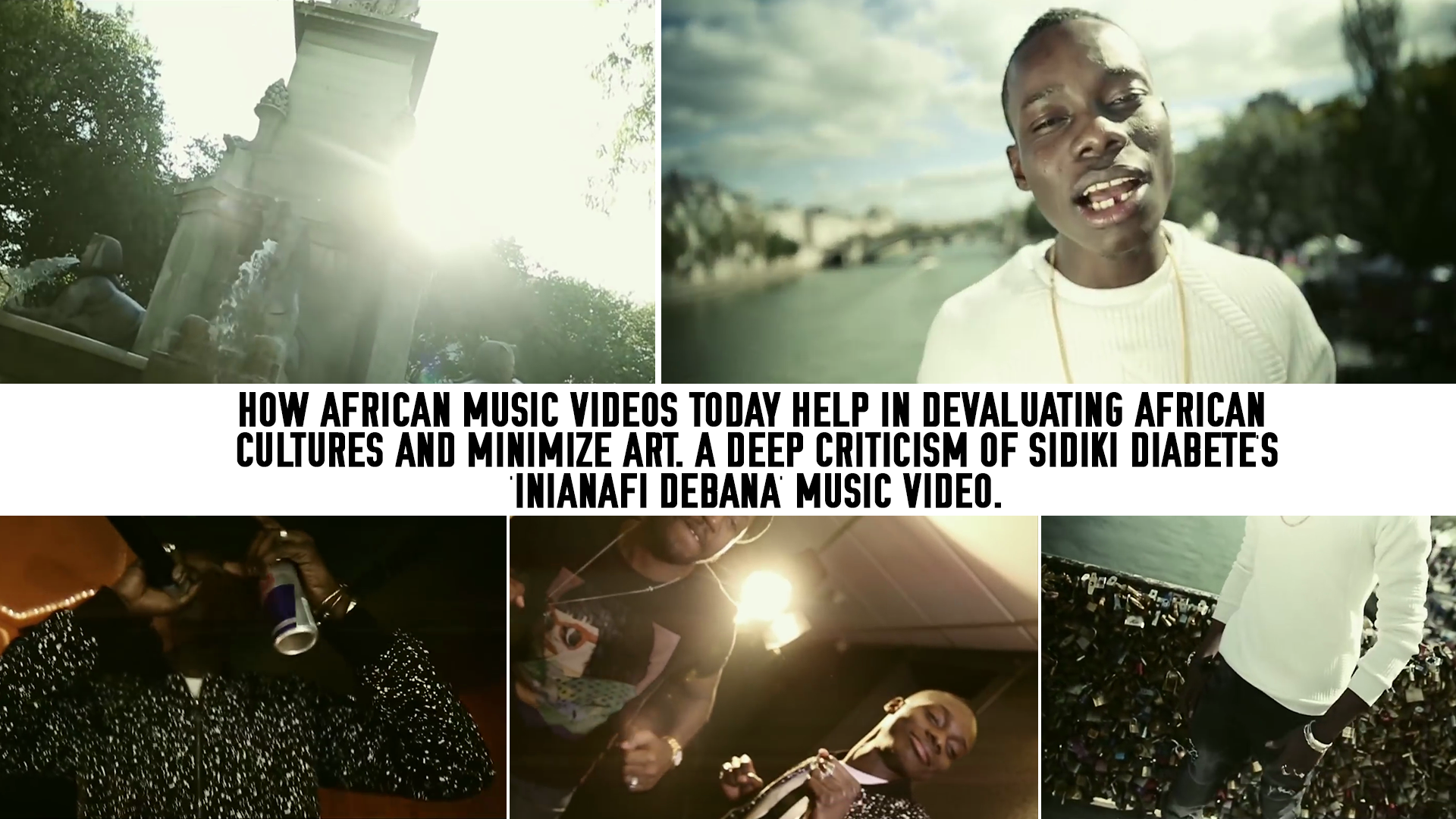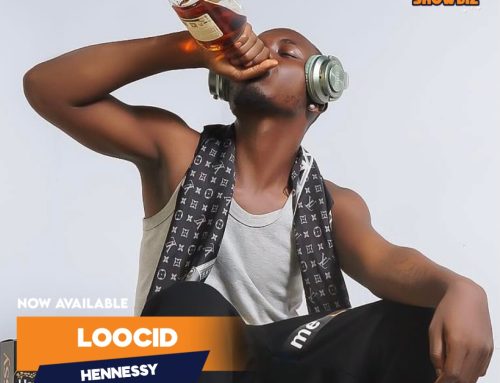‘’Art is the visual/auditory representation of precisions in beauty and esthetics.’’
This article is merely to throw light on how Africans sell their Art in the wrong way to the international market, and in this way, make Africa look like a backward inferior continent with a backward consumer base, and the bad artistic taste of the consumers, who consume every work of ‘art’ without asking questions or without seeing the dangers most of these videos pose for not only the artiste in particular but Africa in General are the first to protest any criticism as regards the product or the artiste. For such Reasons, most of the points below will look far-fetched and doubtful to many readers. But when given some critical thought, will make sense.
Foreword
I picked this video, for many reasons.
- It’s not a Cameroonian in this case, we know why.
- The song is from a Country which is not as endowed as Cameroon, a country on the pillars of Islam, where a lot is restricted especially in music and music videos, because of rich upheld culture.
- Sidiki Diabaté has had great success with his music style in Africa and is taking his music worldwide now.
Diabaté is no longer an amateur in African music, and his success therefore throws light on himself in the music landscape. Africa and Africans will therefore expect their son ‘to represent them well on the international SCENE’, while selling the AFRICAN DREAM, African culture which is rich. We therefore look at him and expect him to not only uphold African culture and values, but to also behave with the spirit of leadership, responsibility and intelligence, traits the world music scene looks for in African ‘Traditional’ music artistes. This is also what potential investors and Brand owners look for while searching for brand Ambassadors from the music haystack for their products.
With his success, Africans in general, especially those that hold dearly to our Culture and dignity there look at Sidiki as possibly an inspiration for our children and future generation of youths.
- The song is rich with African percussions and sounds.
- This article should also act like a yardstick in judging music videos from Cameroon, especially from our successful artistes.
Sidiki Diabaté is a Senegalais songwriter, and singer. And popularly known for popularizing his genre of Music, which he has blended with Hiphop and Afrobeats.
‘Inianafi Debana’ was Sidiki Diabaté’s first music video out of Africa.
Setting
The Music Video was shot in Europe, presumably France. Before this project, he had shot FAIS MOI CONFIANCE, JE SUIS DESOLE, all in his native country, Senegal.
Intention of the Music video
This Music video was aimed at showing that Diabaté has moved to a higher social status in life, and the visible show of success in his career was focal in the video;
- New Life in France
- Being with a Skin-bleached attractive lady
- Hanging around with villains who have piercings on their faces.
- Walking the streets of France like a nobody.
- Holding a concert in a cheap-looking snack bar/hall in France, looking unkempt
The Aim of the music video is to show Diabaté as an accomplished man, who paradoxically, can afford to fly to his paradise, Europe. The European Dream. The yearn for ‘’JE SUIS A PARIS’’ declarations of ostentation and a better life which we seem not to have back in our African Countries.
Intro
The video opens with a scene in which Sidiki Diabaté’s hands are rolling untop a long line of padlocks. His hands are shown in badly-composed shots and his fingers have thick repulsive scars and black spots on the knuckles, things that tell of hardship, servitude in the past; which are not presented on TV with some esthetics and beauty.
Art is a complex thing to amateurs or to people who don’t understand symbolism. So, nothing in a text book or a music should be read at the surface only, we should not just assume shots appear by chance.
<iframe width=”734″ height=”315″ src=”https://www.youtube.com/embed/DELY4vhQTj8″ frameborder=”0″ allow=”autoplay; encrypted-media” allowfullscreen></iframe>
Connoisseur’s Point of View
Everything in a music video is there for a reason, except the video director doesn’t know what he is really doing. In the case of the music video, The Locks already suggest BONDAGE. Our history tells us about slavery and the use of locks and chains to take away people’s freedoms. Our Locks here express Slavery, a mind lacking in intelligence and inferiority.
A creative Director or visual artiste will know that things create new impressions, messages, meaning when placed together, side by side, or in symmetry. Take for example, you are walking by the street and you see a red fluid on the ground that looks like blood. One of the first ideas that come to your mind is that someone injured himself and had bled.
Now, what if there was a knife by the blood, and some blood on the knife. What idea will cross your mind first? MURDER!
That’s how meaning is created when two objects are placed together or share the same space, place and Time.
I believe the director of this music video didn’t know what he was visually putting together for the world to see, subconsciously Joining A to B to create a message.
A in this case is DIABATE, and B, are the locks that act as his background while he is singing and walking.
Shot Compositions
Shot framing is very critical in telling a story. And the better a shot is composed, the more esthetic it looks. Shots are composed with elements on the set; it’s the work of the technical director/director to decide which elements enter the shot and what doesn’t. He decides how the shots should look like, symmetrical, landscape, Medium Shot, Wide, Low angle, etc. The conventions and Laws of Framing of shots for visual storytelling like the RULE OF THIRDS, actually came about because the cinematographers who established these laws actually understood how the eye could be tricked into seeing beauty in shots by reading elements together, or how it can read and pick subtle messages from different shot angles and framing that make up the shot.
However, a music video director or a director can still be creative and shoot without respecting any conventions. However, esthetics and beauty is always the main aim of his shots and his last intention will be to make them look amateurish.
In Diabaté’s Case, the shots were really awful and seemed to respect no conventions of framing, or hardly even expressed the mind of an unconventional creative music video director.
The framing of the shots in most cases was poor because unlike what was intended, many of the shots highlighted a bloat-out look of the artiste-lips and the rough unattended state of the artiste’s physiognomy. All these details cud have been avoided if the make-up artiste was good at his/her job and if the director or DOP was more professional at choosing camera angles. A lot of care hadn’t been taken to soften his face and make him have an imposing radiant look.
The corridor scene, the bridge scene, the club scene, all showed an exaggeration of amateurism and a disregard of the conventions and laws that make art what it is.
To correct a lot of this, we need to know, first, what’s the main aim of music videos. To Sell the Artiste’s Image. This says it all. The better you sell the Artiste’s image, the bigger and better he looks and appears. And the more brands and investors will run to him. The more our citizenry dream each time they see him in a music video and in real life.
Scenes / Shot
A cheap shot reveals a fountain carved out of marble and surrounded by water-spitting creatures. The composition and the angle of view does not permit the audience to appreciate the beauty of the fountain and the art in its design.
Sunshine comes from the back of the fountain, but the entire image still looks washed-out, cheap and amateurish because of poor decision making at the level of DOP or director. A creative music video director will in such a case have brought down the shadows and increased highlights as need be till we get a silhouette shot.
Sidiki again shown in front of locks, in a slow motion shot that accentuates his fallen thick jaws and mouth (usually half ajar). Then the shot changes to show the artiste in splintered jeans. His fingers carry multiple rings, perhaps they carry mystical powers to repel evil.
The shot changes to reveal him walking in the streets of France like an inconsequential tourist or a JJC, with a troop of 2 friends. Nobody even notices him, he is passing like a ghost, and like anybody, no Whiteman seem to recognize him. His three friends seem to be all he has, or seem to be the only people who know or recognize him in France.
The Scene in front of the bridge is ridiculous because of the bad framing that carries no visual aim and that has no visual beauty attributes. The Bad shots that superimpose his bad fat mouth on the camera, the twist and turns of the camera make the shots sickish to watch. The shot on the bridge presents no symmetrical relationship between artiste and background and we can’t even enjoy a steady well framed shot, or even appraise the unrevealed ‘beauty’ of the bridge and River.
If there is nothing wrong with the street scene in which Diabaté is walking with some friends, then tell me am crazy. Wise people have understood the power of showbiz, media and packaging/hyping of artiste, and for such reasons, big/professional labels will not permit any type of content carrying their artiste’s image or which directly/indirectly links to the artiste’s name or label to be made public. This is because it can negatively affect the reputation of the said label or artiste and directly influence sales and sponsorship deals in future.
Street Scene
The street scene actually affects the reputation of Sidiki since it also presents him like a nobody in Europe, despite his huge success in Africa. What I mean here is that, despite the fact that he may still not be known or well known in France, the street shot was very ineffective in making our artiste command respect around him since no one seems to know him. His dressing style, and his sagged trousers actually resonate the Problem of IDENTITY CRISIS in our showbiz milieu and our slow separation from our CULTURES. So, for the reasons given here, the scene didn’t have a place in the music video since it was flat and damaging.
This goes to support what Akon once said in a conference, who said that Africans put the wrong information about themselves on the media. And for this, a lot of potential investors are scared or discouraged.
Corridor Scene
Let’s talk about the night scene in the corridor. The halogen lamp in the background, sidiki and one guy with face piercings, a shallow set, the dressing and the camera framing presents yet another scene full of deficiencies and a display of gross amateurism in set lighting, set building, and creative direction.
Africa’s Top artiste shooting a music video abroad in such a set is nothing but an embarrassment not only for the label, but for Africa in general.
The Room scene.
Sidiki shown in moments of romance on the bed with a beautiful, yellow-skinned lady. This in the director’s view is to sell the idea of new-found aristocracy. This scene goes to highlight our lust for sexual fulfillment, lechery, light-skinned over dark-skinned women when we are able to afford.
What idea/culture are we then selling to the younger generation. What happened to dark-skinned girls in Africa? Don’t we need to also glorify our black skin by highlighting that of our women and girls with dark skins are beautiful?? Why do we put aside our own beauties and pick up another which we think is more beautiful than ours?
Sidiki shown presenting in a club that looks cheap and unworthy as space for such an activity. A mic in one hand, he holds a Redbull energy drink which in every way is an indirect publicity for the Redbull mark and brand. This is a gross portrayal of illiteracy and our inability to market our music and brands effectively.
On the wall of the snack bar, there is a TV set which is on. The hall looks shabby, narrow and takes away each ounce of respect from Sidiki when looked at with a critical eye. When we compare Europeans/Americans with African Artistes, in terms of their mindset to music as business and an artform, we see that Africans are very lacking. Just few African artistes take music as serious business and garner respect abroad.
Many will tell me that his aim was to make the music video look simple, and to show himself like a humble simple, fellow. Of course yes, but the idea failed when Even the director seemed not to understand his job and can’t frame good shots for a top African artiste and it goes unnoticed by us here.
The idea failed when he is presented in a very damaging way. Simple Videos are very artistic or have some art in them, but this one looks like a series of errors.
Had the shots of the concert in the snack bar been framed differently, the shots would have made a lot of sense and command respect.
The product
The video was very meagerly done, its art is lacking and greatly contrasted the effort at ostentating wealth and success in the video. The shots look cheap, the scenes look cheap, the dressing look cheap, the make-up look cheap, and the coloring of the video looks cheap.
It shows we have no attention for detail, our market is still backward and its customers still appreciate the basics of art or what seems to be like art…which to me in George Lucas’s eyes, is a series of errors.
Africans don’t know how to value esthetics and beauty. Because we praise the mediocrely done.
Art is like poetry, you can interprete it in many ways. Music videos to have many ways they can be appreciated. But this music video has nothing deep in it, as you see it, so shall you understand it. Nothing to interprete or decipher. Point blank.
WATCH EDDIE Murphy’s COMING TO AMERICA, it showed the African culture in all its beauty. The show of power and wealth, the showcase of the lionheart by the king’s collar skin, this video help carve AFRICA CULTURE IN GOLD INFRONT OF THE WHITE WORLD. THOUGH HE STILL HAD TO come to America to look for a wife, this film then becomes a blend of two cultures that live with each other without hurting the other.
Dressing
We all know about the rich culture of the Senegalese, their dressing, their food, their strong moral values etc., and Sidiki as an artiste had in every way had as duty to sell that culture to the Whiteman at the highest price.
In the music video Sidiki is shown in an array of dresses, none of which reflect his culture which his music represents. We see him in a white pullover, a jacket, jeans trousers, rings on his fingers, sagging trousers. The scene in which he is playing the African instrument, his dressing in no way tells any story in the video, it has no history to it except the western idea of dressing.
The lead girl
A song that is rich in African percussion, African sounds, and which is African in vocals show off a lady who does not in any way add value to the African woman and her dark Skin. The lady in the music video looks European, has light skin.
Her role in the video is that of a girl friend or wife, and the aim of her role is to show that she is that woman only for successful people. I thought that since his music is purely African, we will instead see a dark-skinned girl who will show off her dark skin to the world.
I therefore failed to see the cross-cultural aim in the music video.
The lady in question isn’t even a good actress. Her looks and facial expression either show fatigue, uneasiness, and an absence of basic excitement which we would have expected from a lady being cuddled or sung to by an artiste with so much success like Sidiki.
So her role was really inconsequential except to portray Wealth, and really does not contribute to the development of the plot in the music video.
Storyline
The storyline in the music video is very haphazard. We see sidiki walking though the streets of France, like a tourist, and we are shown nothing of what he is looking at.
There is movement in the B-roll scenes, but we fail to see where our artiste is heading to in the music video, we just see him walking, and the shots remain on him, which is not effective in this case.
The storyline goes like this: Sidiki walking in the street with friends, shown with girl in bed, shown at concert. There is no effective development of the character and the story as the video unfolds.
Criticism of the director’s use of Setting
My first question was the reason why France was chosen as the location of the music video. My guesses were given above. Though I stil believe this video could still have been shot in Senegal with more artistic and visual effectiveness.
Most of the places shot or shown in the music video, as well as the setting of the scenes are some of the places that are either not tourist destinations or don’t reflect the finesses of French Aristocracy or high class. The places shown in the music video are places available and accessible to everyone, and which is seen everybody by everyone passing through them.
It therefore means that using these same places as a backdrop for Sidiki is nothing but an insult to his brand and his personality. So, these places, used as scenes in the music video therefore present the artiste as cheap, low, having little taste in beauty and desperate.
The bad framing of the shots and the poor presentation of the scenes actually fail to provide us with details with which we can best see beauty in the scenes and appreciate.
Art and Art Appreciation
Art is the visual/auditory representation of precisions in beauty and esthetics.
In the law of science, to calculate distance, we need two points, because one can’t distance without first knowing the position of the reference. There must be a relationship of two things in terms of their position in space for measurement to be effective.
However, Art is a mysterious thing, and with art, u don’t need to know what beauty is before u can judge art.
Beauty can be picked out by the eye, without the observer even having any basic understanding on Art Appreciation or how to read an artwork. What’s beautiful and esthetic, can remain beautiful and Esthetic across cultures.
Conclusion
At the end of the video, we have to ask ourselves, what is SIDIKI Diabaté really selling through his music, which can make him have more relevant in and out of Africa with his music. His music and percussions have this fufulbe/Hause/Moslem melody. That is the genre of music our boy is selling to the world, but he fails to make himself visually look like the Ambassador of that culture that he is selling. He presents himself like a ruffian with sagging trousers.
The whole concept of this music video is so embarrassing and hurtful to the African spirit, to the critical African, and to our culture since it sells actually nothing from here to the world other than expose our vulnerabilities, amateurism, bad taste in art, identity crisis, Our European Dream, our idea of success to the world at large which will only look low at us.
It shows a boy who has left the jungle, gone to France and looks excited. This is the bad image most of our African music videos sell to the world.
The Foundation of the music business is the sale of our Rich Cultures. America has understood this, and that’s why they have highly skilled personnel in each field that is a contributing factor in the creation and marketing of art.
Look at the success of Wes Madiko, Selif Keita, Youssound’our. These people sang and breathed their cultures in their music. They actually live their cultures and that has remained their selling points. One has a Grammy Award; others are laureates of top African/World Music Awards.
By Nforche Gerald







u are very right and all D’s words must go to d ears of Mr LEO and d rest , look at Mr LEOs recent release desole , it was same idea with his man salatiel , am I wrong ? so we need all D’s advice’s .
sidiki is malien